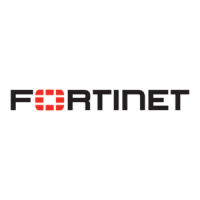
Do you have a question about the Fortinet FortiNac BFN620 and is the answer not in the manual?
| Model | BFN620 |
|---|---|
| Product Type | Network Access Control Appliance |
| Form Factor | 1U Rack-mountable |
| Management Interface | 1x GE RJ45 Management Port |
| Power Supply | Redundant power supplies |
| Operating System | FortiNAC OS |
| Supported Protocols | RADIUS, SNMP |
| Certifications | FCC, CE, UL |
Details on locating the Appliance Identifier tag and using it to determine the Product Descriptor.
Explanation of Product Descriptors and their use in the Configuration Wizard for common naming schemes.
Details on the purpose of each Ethernet port during initial configuration and normal operation.
Summary of hardware setup steps, including connecting the appliance and launching the wizard.
Summary of software configuration steps, including network settings and passwords.
Connect your PC to the appliance's eth1 port and navigate to the configuration wizard URL.
Access the hardware setup configuration wizard using default credentials.
Screen for entering the unique License Key required for application operation.
Defines fields for Host Name, IP Addresses, and Default Gateway in the basic network configuration.
Configuration options for DNS servers, NTP server, and system time zone.
Details on required and prohibited symbols, length, and types for system passwords.
Warning against using firewalls between FortiNac appliances as it interferes with connections.
Access the software configuration wizard using the appliance's IP address or hostname.
Option to download supporting PDF documentation for appliance configuration and administration.
Interface for changing admin, root, and configuration wizard passwords.
Detailed definitions for each password field in the setup process.
Choose between Layer 2 (VLANs) or Layer 3 (routed) network configuration for the appliance.
Defines various VLAN types like Isolation, Registration, Remediation, etc., for network access control.
Steps for configuring isolation VLANs, including IP addresses, masks, and VLAN IDs.
Configuration of additional routes for the Layer 2 network.
Review and apply configured settings for the Layer 2 network setup.
Defines different route scopes like Isolation, Registration, etc., for routed network environments.
Steps for configuring Layer 3 isolation route scopes, including IP addresses and lease pools.
Configuration of additional routes for the Layer 3 network, including examples.
Review the configuration results for errors or warnings and make necessary adjustments.
Options to reboot or shut down the appliance after configuration to apply changes.
Enter root/YAMS credentials to access the system's graphical user interface.
The wizard displayed after login to set up network access for users.
Access the dedicated window to change system passwords after initial configuration.